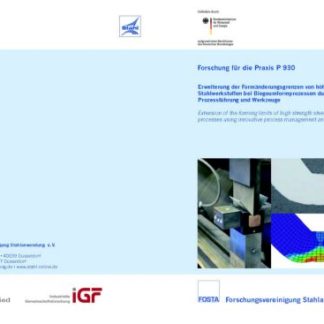Description
P 830 – Investigation of damage and formability of the sheared edge of dual-phase steels with the help of the multiscale finite element analysis
The demand for lighter and safer cars leads to an increasing application of dual-phase sheet steels in the automotive industry. One of the current difficulties in processing of these steel materials is their low edge formabilityafter cutting, which considerably impairs the intensity of subsequent forming. The insufficient cut edge formability has been shown to be attributed to material damage, which appears in the form of small pores between martensite and ferrite in the cut edge area of the sheet material. During cut edge extension, these pores grow and coagulate to microcracks that extend under an applied load leading to an edge crack. So far, there exists no generally accepted method to determine the cut edge formability and to consider it in the forming simulation. As a result, only significantly lower cut edge deformations are often allowed in the design of forming processes than dual-phase steels could actually withstand without fracture.
The objective of the project was the development of a practical approach to consider cutting-induced damage in dual-phase steels by finite element analysis of subsequent forming operations. This was to allow a realistic estimation of the residual formability of the cut-edge zone of dual-phase sheet steels with the help of established software packages for finite element analysis. Two dual-phase sheet materials with an ultimate tensile trength of 600 MPa and 780 MPa and a thickness of about 1.4 mm were in the focus of the project.
The following solution approaches were elaborated and investigated: an extended forming limit diagram; damage modelling with the help of the Johnson-Cook damage model parameterised on a cutting process; damage modelling with the help of the Johnson-Cook damage model parameterised on material characterisation tests; damage modelling with the help of the Gurson-Tvergaard-Needleman damage model parameterised on material characterisation tests; micromechanical damage modelling with the help of a representative volume element. This report presents an evaluation of these solution approaches regarding their experimental and simulation costs on the one side and their quality of the failure prediction on the other side and suggests directions for future research work.
The extended forming limit diagram is found to be a pragmatic solution approach, which can be easily used in industry. For generalisation of this approach, it can be recommended to quantify the influence of pressuresuperposition during edge extension in real forming processes on the edge formability and study it with various laboratory characterization tests in the future. Due to the high complexity, the micro-mechanical damage modelling is currently evaluated as less relevant for the industrial practice. However, a further development of this solution approach seems to be promising for obtaining a better understanding of mechanical properties of dual-phase steels. The solution approaches that are based on a transfer of the damage distribution from the cutting simulation to the forming simulation require a good agreement between the experimental and numerical results of cutting. However, this could not be achieved in the project. To move forward in this issue, further research on the transfer of the experimentally determined material forming limits to the numerical simulation of cutting is necessary.
The research project was carried out at Institut für Umformtechnik und Umformmaschinen, Leibniz Universität Hannover,. FOSTA has accompanied the research work and has organized the project funding from the Foundation for Steel Application Research for the institute.
Only available in german language.
Authors:
B.-A. Behrens, M. Vucetic, I. Peshekhodov, M. Schneider
Published in:
2015




